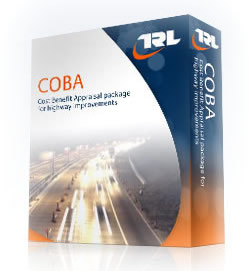

UK Department for Transport Cost Benefit Analysis (COBA)
The Department for Transport (DfT) use Cost Benefit Analysis (COBA) for evaluating the costs and benefits of new trunk road developments in the UK. COBA focuses on each link of the proposed development separately. It identifies the main benefits in terms of time savings, and the value of reduced accidents. These benefits are compared against costs of construction and maintenance. Consideration is also given to the ‘do nothing’ approach.
Costs
COBA considers two main forms of costs, capital costs and maintenance costs.
- Capital Costs: Capital costs include the construction costs including land purchase, design etc. Estimates are also included for traffic delays caused by construction.
- Maintenance Costs: These include the annual costs of maintaining the new road. This is divided into non-traffic-related and traffic-related costs. Non-traffic maintenance costs include drainage and lighting, while traffic related costs include resurfacing and patching.
Benefits
COBA considers three main categories of benefits. These are journey time-savings, vehicle operating cost savings, and reductions in accidents.
Journey time-savings:
This is calculated by investigating the time reductions for road travel obtained through projects which reduce traffic congestion, for example, the M1 road-widening. Time-savings are categorised into:
- Working Time: This considers the average hourly wage rate.
- Commuting Time.
- Other Time.
The table below shows the values used in COBA for various types of vehicles and travel. The hourly flow of people using a new trunk road is calculated by multiplying each of the types of vehicle, and occupancy rates. Occupancies vary, which is taken into account as can be seen in the table. The occupancy rates are multiplied by the actual time savings generated, and then the value of their time, shown in the right column. This value is then converted to actual market prices by multiplying them by (1 + t) where t is the average rate of indirect taxation.
Type of Vehicle |
Purpose |
Weekly average occupancy |
Value |
|
Per Occupant |
Per Vehicle |
|||
Car |
Working |
1.00 Driver |
2186 |
2499 |
|
Commuting |
1.00 Driver |
417 |
475 |
|
Other |
1.00 Driver |
368 |
681 |
LGVs |
Working |
1.00 Driver |
842 |
1010 |
|
Commuting |
1.00 Driver |
417 |
663 |
|
Other |
1.00 Driver |
368 |
585 |
OGVs |
Working |
1.00 Driver |
842 |
842 |
PSVs |
Working |
1.00 Driver
|
842 |
5916 |
Average Vehicle |
|
|
930 |
|
Vehicle operating cost savings:
This considers the reduction in wear and tear, and increased fuel efficiency achieved by reduced congestion.
Reduced Accidents:
This represents the value of lives saved and non-fatal accidents avoided and is included in COBA. The relative costs used by COBA associated with different severity of injury are as follows:
Cost per Casualty (£) |
|
Fatal |
1,249,890 |
The accident costs are as follows:
|
Cost per accident (£) |
||||||
|
Damage to Property |
Police Time |
|||||
|
Insurance |
Urban |
Rural |
Motorway |
Urban |
Rural |
Motorway |
Fatal |
230 |
5,977 |
10,136 |
12,894 |
1,463 |
1,387 |
2,030 |
Serious |
143 |
3,203 |
4,620 |
11,002 |
122 |
341 |
320 |
Slight |
87 |
1,890 |
3,063 |
8,566 |
44 |
44 |
44 |
Damage-only |
42 |
1,352 |
2,019 |
1,941 |
3 |
3 |
3 |
Note that using COBA definitions, urban roads are those with speed limits of 40mph and below, over 40mph are classified as rural roads. Estimates are then calculated in relation to the likely reduction in accidents resulting from the road development, and the proportions of each type of accident (see DfT (2009) for more on this).
Criticisms of COBA
A number of criticisms exist with the current form of COBA used by the Department for Transport in the UK. Firstly COBA suffers from many of the usual problems associated with CBA including quantification, and the appropriateness of applying monetary valuations to certain costs/benefits such as life. However, COBA is also criticised for its narrow focus on user-costs and benefits. |
 |
Some analysts, and particularly environmentalists, argue that COBA does not adequate consider the wider implications and effects of projects. These include the environmental impacts of new roads or road widening, and the potential social impacts associated with projects, such as taking the flow of traffic away from areas which may impact businesses in an area e.g. hotels, cafes, pubs, petrol stations etc. Since 1998, though, COBA has been used not alone, but as part of wider appraisal method which does provide some consideration of these factors. However, this wider appraisal method is not without criticism. It uses a 7 point scale for appraising these environmental and social factors, which some argue is too simplistic and does not give due consideration to the wider impacts of certain projects.
- Discounting
- Discount/Compound
- Horizon Values
- Sensitivity Analysis
- Results
- NPV
- BCR
- Comparing NPV and BCR
- Downloads
- CBA Builder
- Worksheets/Exercises
This work is licensed under a Creative Commons Attribution-NonCommercial-ShareAlike 3.0 Unported License.

This resource was created by Dr Dan Wheatley. The project was funded by the Economics Network and the Centre for Education in the Built Environment (CEBE) as part of the Teaching and Learning Development Projects 2010/11.
Share |



